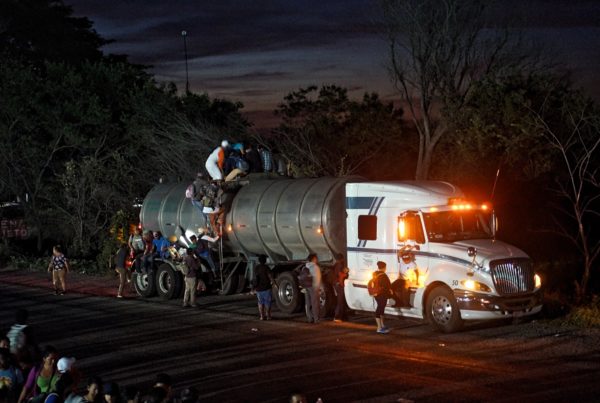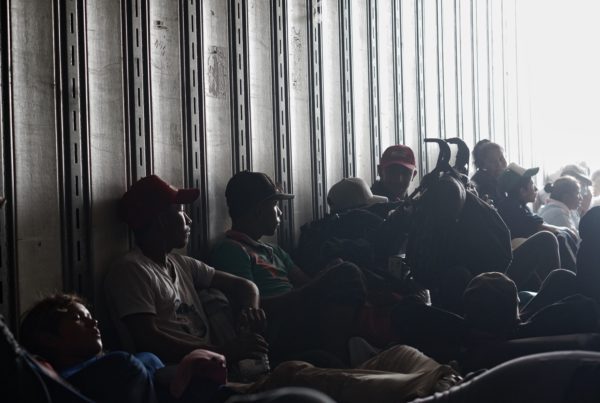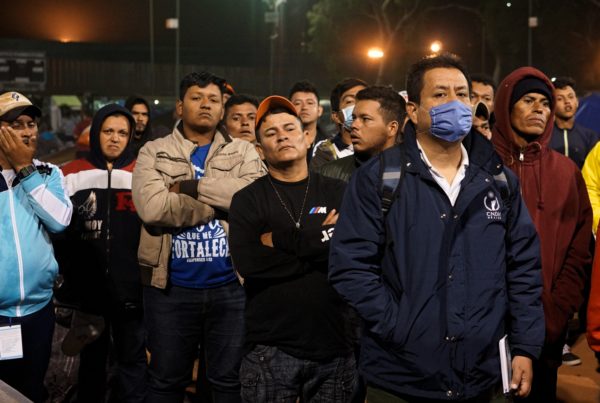I arrange dinner with the lady behind the barred windows. She cooks us eggs and, despite her initial distrust, offers us potato chips and refrescos free of charge in a show of Mexican hospitality.
That evening music plays in the streets and people mill about. Groups of teenagers loiter and flirt with each other, which makes me think of a summer vacation on the coast. Despite the seriousness of the situation the people appear upbeat, even optimistic. They are in charge of their own fate, for the time being at least.
Nevertheless, people are clearly tired. One woman from Guatemala shows me the red-raw blisters on her feet with a laugh. The caravan has already travelled close to 1,000 kilometres since it set out from the city of San Pedro Sula in Honduras on 12 October, and they still have a long way to go to reach the US border.
We are leaving at 3am the next morning, an early rise to avoid the heat of the day. My compañeros fall asleep immediately. I am kept awake by the sound of barking dogs, the infuriating buzz and bites of mosquitoes, the flashing lights of police patrols, swirling winds and a swinging hammock.
I leave my hammock long before the hustle and bustle of the morning pack-up begins. American reporters are already pointing their cameras and bright lights in the faces of sleeping children. According to Antonio, the local community organised buses to transport women and children on to the next destination. Long lines form to board the buses, but not everyone can fit. There are arguments about who can board, illuminated by the bright lights of American cameramen. A mise-en-scène of conflict and desperation to broadcast all over the United States.
Those not fortunate enough to board buses head to the highway with their meagre possessions in hand.
People congregate again at a highway petrol station just outside town where they can approach trucks heading west and ask permission to board. If the truckie says yes, they climb on top of the tanker, in between the tanker tray and the cabin, hanging on to the back, wherever they can get a firm hold.
It is usually the adventurous young men who follow this method, willing to risk their lives for any kind of assistance on the long journey. They catch rides from whomever they can, even farmers with tractors. The unfortunate many who can’t get lifts begin the slow march on foot, pushing prams, carrying children and luggage. Today the caravan is headed for the town of Juchitan de Zaragoza: 53 kilometres away; one hour by car. I don’t know how long it would take to walk that distance.
I thought there would be more cohesion to the caravan. Perhaps I imagined them to march as one, singing solidarity songs like an anti-war protest. What I witness is much more chaotic than that. In some ways, it’s every person for themselves. The members of the caravan are united by a singular goal: to reach America. Nothing more than that.
Judging by the media attention in the United States surrounding the caravan, it would be easy to assume this was a unique phenomenon. However, this isn’t the first such caravan to pass through Mexico.
For the past several years, Mexican advocacy groups have held an annual caravan of Central American migrants. The most recent to set out was in April this year; a caravan of 1,500 people which dwindled to a few hundred by the time it reached the US-Mexico border. What makes the current caravan different is its size and the fact that it has come at a politically significant time.
In the lead up to the midterm elections, President Trump ramped up his already virulent anti-migrant rhetoric. His attempts to whip up hysteria have included baseless accusations that there are “criminals and unknown Middle Easterners” in the caravan. He even claimed that Democrats were “openly encouraging caravan after caravan of illegal aliens to violate our laws and break into our country”.
These claims were followed up by an announcement from the Department of Defense and Department of Homeland Security to deploy 5,200 additional troops to the border to join the thousands of Customs and Border Protection officials, as well as 2,100 National Guard personnel, already there. Trump has suggested the US may deploy as many as 15,000 troops to the border, more troops than are serving in Iraq and Syria.
Blaming migrants for fleeing poverty and violence is a simple response to a complex problem. A better way to stem the future flow of migrants might be to re-examine US foreign policy in Central America. Ongoing US intervention in El Salvador, Honduras and Guatemala, has destabilised and militarised the region, leading to an increase in migration to the US.
While Trump deliberately provokes racial tension, there were two frightening incidents of domestic terrorism in the US. Pipe bombs were mailed to Democratic Party leaders and eleven, elderly Jews were murdered in a Reform synagogue in Pittsburgh. It would appear US citizens have more to fear from their own countrymen than from the members of this caravan.
What’s more, with reports of American citizens acting as vigilante border patrols, perhaps the migrants are the ones who should be afraid of Americans.



